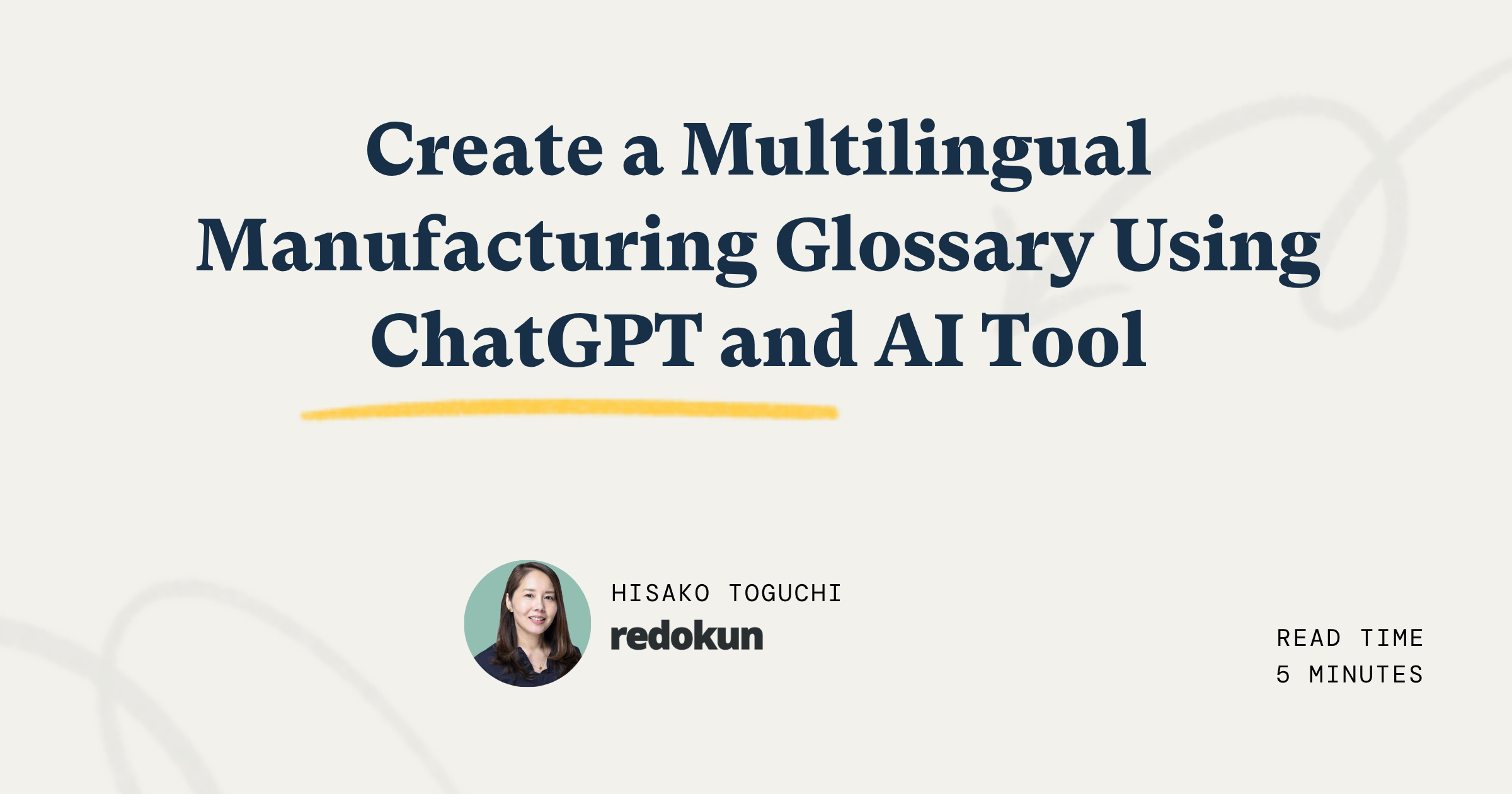If you work in manufacturing marketing, you already know how complex multilingual content can get. You need to manage a large volume of documents in many different file formats and translate them into multiple languages to sell in global markets.
A translation glossary is one of the best tools you can have. It helps your translators (and marketing teams) stay consistent with product names, technical terms, and key expressions across ally our materials.
But creating a glossary from scratch can feel overwhelming, especially when you’re managing multiple product lines or language versions.
Here’s the good news: you can use ChatGPT (or any AI tool of your choice) to create the first draft of your multilingual glossary in minutes.
In this post, you’ll learn:
- why a glossary is essential for manufacturers,
- how to use ChatGPT to create one quickly, and
- ready-to-use prompts you can copy and paste right now and generate your draft glossary lists.
Why Manufacturing Marketers Should Create a Glossary
When you’re translating technical and marketing materials, precision and consistency matter.
A glossary helps ensure that:
- Product and component names stay consistent across every brochure, data sheet, and country site.
- Technical terms are translated accurately — avoiding errors that could confuse distributors or customers.
- Marketing phrases and taglines sound natural in each market, while preserving your brand’s tone and credibility.
Whether you use in-house translators, agencies, or tools like Redokun, a glossary saves time, money, and endless correction rounds —especially for manufacturing teams that translate content regularly.
How to Create a Glossary with AI
You can ask ChatGPT to analyze your website or even a technical document and generate a draft glossary automatically.
Just copy and paste the prompt below into ChatGPT (ideally the version with web browsing and file download enabled) or any AI tool of your choice.
Copy-Paste Prompt: Build a Glossary from Your Website
I’m a [your role — e.g. marketing manager, localization specialist, etc.] working at [your company name].
We translate our marketing and product content into multiple languages and would like to create a glossary to standardize key terms and ensure consistent translations.
Please check our website [insert your website URL] and build a glossary in Excel format with the following columns:
| Source Language | [Target Language 1] | [Target Language2] | [Target Language 3] | Category | Notes |
Use these category definitions:
- Do not translate: English terms that should remain unchanged (e.g. product names, model codes, brand names).
- Technical term: Product or industry-related terms that require careful translation (e.g. components, materials, processes).
- Marketing expression: Taglines, calls to action, or key phrases that carry tone or emotion beyond literal translation.
Instructions:
- Review my content and identify 10–50 relevant terms orphrases.
- For languages where translations already exist, use thoseas target entries.
- For new languages, suggest translations based on meaningand tone.
- Include a short note for any term that might havemultiple meanings or needs a specific tone (e.g. formal vs. casual).
- Export the final glossary as an Excel file I can download and review.
Alternative: Create a Glossary from YourTechnical Documents
Many manufacturing teams already have rich source material — product catalogs, manuals, installation guides, spec sheets, or translated documents created by distributors or partners.
If you upload these documents to ChatGPT, it can extract terminology directly from them and build your glossary automatically. This is especially useful when:
- Your terminology is highly technical
- Your product line includes many components or variants
- You already have translations but need to create glossaries across target languages
- You want consistency across legacy and new materials
Just upload your documents (source language + optional translations) into ChatGPT and use the prompt below.
Copy-Paste Prompt: Build a Glossary from Documents
I want to build a multilingual glossary based on the document(s) I’ve uploaded.
These documents include technical and marketing content for our products, and I need to extract key terminology to ensure consistent translations across languages.
Analyze the uploaded document(s) and identify:
- Product names, model names, and component labels
- Technical terms related to materials, specifications, or processes
- Repeated terminology used in manuals, data sheets, brochures, or catalogs
- Marketing phrases or product positioning statements
- Terms that should remain in the source language for brand or technical reasons
If multiple languages are present (e.g. English + French versions), align the corresponding terms side by side.
If only the source document is provided, extract the source language terms and suggest translations for these target languages:
- [Target Language 1]
- [Target Language 2]
- [Target Language 3]
Create a glossary in Excel format with these columns:
| Source Language | [Target Language 1] | [Target Language2] | [Target Language 3] | Category | Notes |
Use these categories:
- Do not translate
- Technical term
- Marketing expression
Include 10-50 glossary entries based on relevance.
Add notes for any term that may require clarification or has multiple possible translations.
Export the final result as an Excel file I can download.
What You’ll Get
Your AI will generate a draft glossary with:
- your source terms and their translations(or suggested translations),
- categories (Do not translate, Technical term, Marketing expression), and
- notes explaining tone, usage, or translation choices.
You can then review the file internally or share it with your translators.
Final Tip
Once your glossary is ready, make sure to share it with all parties involved. That way, everyone working on translations knows exactly which terms to use(and which ones to leave in the source language). To learn more, read our article: Howt o Create a Great Glossary for Manufacturing Translations: Best Practices.
If you have ongoing translation needs, using a translation management system like Redokun with an integrated glossary can help you achieve the accuracy and consistency you’re looking for.
Want to see how Redokun helps manufacturers streamline glossary management and translation workflows? Read our customer stories or start your free trial.




